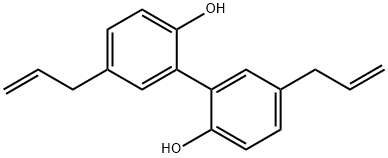Magnolol , Analysis of standards,> 98% , 528-43-8
Synonym(s):
2,2′-Bichavicol;5,5′-Diallyl-2,2′-biphenyldiol
CAS NO.:528-43-8
Empirical Formula: C18H18O2
Molecular Weight: 266.33
MDL number: MFCD00016658
EINECS: 610-903-7
| Pack Size | Price | Stock | Quantity |
| 20MG | RMB71.20 | In Stock |
|
| others | Enquire |
PRODUCT Properties
| Melting point: | 101.5-102° |
| Boiling point: | 180°C/1mmHg(lit.) |
| Density | 1.107±0.06 g/cm3(Predicted) |
| FEMA | 4559 | MAGNOLOL |
| storage temp. | Sealed in dry,2-8°C |
| solubility | ethanol: soluble1mg/mL |
| pka | 9.49±0.43(Predicted) |
| form | Solid |
| color | White to Almost white |
| Odor | bitter |
| biological source | plant |
| λmax | 292nm(EtOH)(lit.) |
| JECFA Number | 2023 |
| Merck | 14,5697 |
| Stability: | Light Sensitive |
| LogP | 4.502 (est) |
| CAS DataBase Reference | 528-43-8(CAS DataBase Reference) |
Description and Uses
Magnolol is a bioactive compound isolated from the bark of M. officinalis that has been used in Asian traditional medicine for the treatment of anxiety, sleep disorders, and allergic diseases. Magnolol can activate cannabinoid (CB) receptors, behaving as a partial agonist with selectivity for the peripheral CB2 subtype (EC50 = 3.28 μM; Ki = 1.44 μM) versus central CB1 (EC50 = 18.3 μM; Ki = 3.15 μM).
Magnolol is the bioactive phytochemicals found in Magnolia officinalis (1). Magnolol has been used to treat anxiety, cough, headache and allergies (2). It also inhibits tumor necrosis factor-a-*induced ICAM-1 expression in human lung epithelial cells.
Safety
| Symbol(GHS) |    GHS05,GHS07,GHS09 |
| Signal word | Danger |
| Hazard statements | H315-H318-H335-H411 |
| Precautionary statements | P273-P280-P302+P352-P305+P351+P338+P310 |
| Hazard Codes | N |
| Risk Statements | 37/38-41-51/53 |
| Safety Statements | 26-39-61 |
| RIDADR | UN 3077 |
| WGK Germany | 3 |
| RTECS | DV5105500 |
| HS Code | 29072990 |
| Hazardous Substances Data | 528-43-8(Hazardous Substances Data) |
| Toxicity | LD50 orl-mus: 2200 mg/kg BRXXAA #5135746 |



